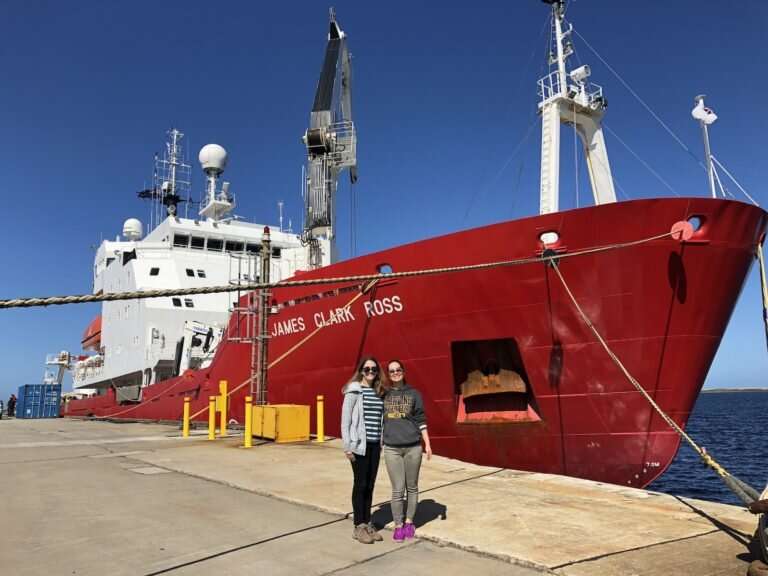Study uses plankton genomes as global biosensors of ocean ecosystem stress

By analyzing gains and losses in the genes of phytoplankton samples collected in all major ocean regions, researchers at the University of California, Irvine have created the most nuanced and high-resolution map yet to show where these photosynthetic organisms either thrive or are forced to adapt to limited quantities of key nutrients, nitrogen, phosphorus and iron.
As part of the new Bio-GO-SHIP initiative, the UCI scientists made eight deployments on six different research vessels, spending 228 days at sea in the Atlantic, Pacific and Indian oceans. They generated nearly 1,000 ocean metagenomes from 930 locations around the globe, with an average distance between collection points at 26.5 kilometers (about 16.5 miles).
In a study published today in Science, the UCI researchers explain how they used a wealth of information embedded in microbial genes—specifically from the species of phytoplankton Prochlorococcus—as a biosensor of ocean health and productivity. Oceanographers working in this field are keenly interested in understanding how these organisms adapt to "nutrient stress," which is the struggle to find or use the essential substances they need in order to grow and reproduce.
"Phytoplankton are foundational to the marine food web, and they are responsible for as much as half of global carbon dioxide fixation on an ongoing basis, so the health and distribution of these organisms is very important," said senior co-author Adam Martiny, UCI professor of Earth system science. "The knowledge gained on these voyages will help climatologists make more sound predictions about the role of phytoplankton in regulating carbon stocks in the atmosphere and ocean."
Since microbial phytoplankton live in large populations and have rapid life cycles, the researchers suggest that changes in community composition and genomic content can provide an early warning about environmental transformations and do so far faster than by merely analyzing ocean physics and chemistry.
"Nitrogen, phosphorus and iron limitation in many surface ocean regions is nearly impossible to detect through chemical analysis of water samples; the quantities of these elements are just too low," said lead author Lucas Ustick, a UCI graduate student in ecology & evolutionary biology. "But quantifying shifts in Prochlorococcus genes involved in the uptake of major nutrients, and combinations thereof, provides a strong indicator of the geography of nutrient stress."
The authors pointed out that all Prochlorococcus genomes include a certain gene that allows phytoplankton to directly assimilate the inorganic phosphate freely available in seawater. But when this compound is in short supply, phytoplankton adapt by gaining a gene that enables the cells to take up dissolved organic phosphorus, which can be detected in their genome.
The researchers also studied numerous other examples of genetic adaptations for differing levels of phosphorus, iron and nitrogen in the environment to see what sorts of trade-offs the phytoplankton are continuously making. What resulted is a global map of nutrient stress. The researchers also were able to identify regions where phytoplankton experience co-stress involving two or more elements, one of them almost always being nitrogen.

The team's work revealed the North Atlantic Ocean, Mediterranean Sea and Red Sea to be regions of elevated phosphorus stress. Genotypes adapted to nitrogen stress are widespread in so-called oligotrophic regions where nutrients are low and oxygen is high, and research sampling results suggest widespread adaptation to iron stress.
Analysis of phytoplankton genotypes confirmed known biogeographic patterns of nutrient stress estimated by different techniques, but it also revealed previously unknown regions of nutrient stress and co-stress. The researchers had a scant understanding of nutrient stress in the Indian Ocean prior to their metagenomic analysis, but their work helped to fill in many blanks. They now know the Arabian Sea upwelling region to be an area of some iron stress, and they detected phosphorus stress associated with to south-flowing ocean currents, among many other findings.
Still, they say, there is always more to learn.
"Our work highlights gaps in our measurements of high-latitude environments, in most of the Pacific Ocean, and in deeper-water ecosystems," said co-first author Alyse Larkin, UCI postdoctoral scholar in Earth system science. "The progress we made on our recent expeditions inspires us to head out and cover the whole planet."
More information: "Metagenomic analysis reveals global-scale patterns of ocean nutrient limitation" Science (2021). science.sciencemag.org/cgi/doi … 1126/science.abe6301
Journal information: Science
Provided by University of California, Irvine





















